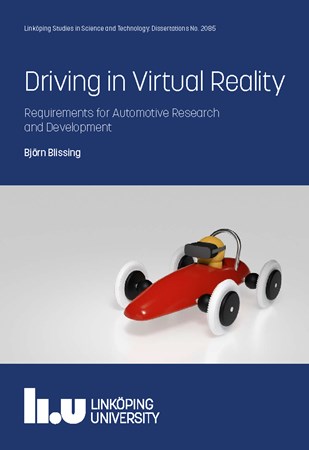Complex testing
The increasingly advanced safety systems in modern cars make testing them both more important and more complex. The first step is normally to run simulations in software. The hardware is then taken for test drives on a track and/or tests in driving simulators. These methods have both advantages and disadvantages.
Tests run on a track are close to reality, using real cars and in some cases drivers. It can, however, be complicated to set them up and may in the worst case involve risk for the operators. The tests also often need a long period of preparation and are expensive. Driving simulators offer the opportunity to carry out complex experiments in a safe environment, but suffer from other problems. The simulators are very expensive and often lead to undesired secondary effects such as motion sickness.
Björn Blissing shows a pair of older VR-glasses. Photo credit: Mikael Sönne
In his doctoral thesis Driving in Virtual Reality: Requirements for automotive research and development, Björn Blissing, principal research engineer at the Swedish National Road and Transport Research Institute, investigates a third method: virtual reality. Several tests have been conducted in which drivers on a test track drive a normal car, wearing a VR headset. The technology makes it possible to simulate a broad spectrum of traffic situations and safety-critical problems.
Björn Blissing started work on the thesis in 2013, when the most recent generation of VR was still in its infancy.
“During the first few years, I was in contact with many of the enthusiasts and start-up companies that were developing the various VR headsets. We even built our own prototypes. Now, however, the development is led by large companies and a lot of money is being thrown at the field, not least for applications in the gaming industry”, says Björn Blissing, who also in his leisure time enjoys playing computer games with VR.
Driver response in VR
One main question for the research was how similar the driver response while driving with VR is to the response while driving without it. In other words, how exact the experiments with VR can be, and – ultimately – how useful the results are. Some of the many experiments have compared the driver’s perceptions of speed and distance with and without the VR headset.
In one experiment, the driver was asked to drive at 40 km/h without looking at the speedometer. In another experiment, the distance at which they could distinguish between different road signs was measured.
“When estimating speed, there were only small differences between with or without VR. However, visibility was significantly poorer when using VR, simple because of the lower resolution it uses. We’re still quite a long way from reality. But new technology is on the way that will be significantly better”, says Björn Blissing.
The VR headsets currently available also make it difficult to display objects at different distances. The screen in the VR headset is at a fixed distance from the eyes, which confuses the brain’s depth perception. Carrying out tasks such as changing focus between near and far objects can therefore cause eye fatigue, and in the worse cases motion sickness.
Less motion sickness
Virtual reality is used in many tests at VTI, for example the reactions of pedestrians.
On the plus side, taking curves in VR is closer to reality than it is in driving simulators, where drivers often tend to drive too widely and oversteer. Problems with motion sickness, which can be quite considerable in driving simulators, also seem to be less in VR.
“At least, that’s the tendency we’ve seen”, says Björn Blissing, carefully, and points out that he is not claiming that the results are definitive.
In summary, VR-aided driving can become an important part of testing the safety systems in cars. But not on its own.
“I see it as an important tool in the box, intermediate between simulators and driving on a test track. It’s not going to replace traditional test driving, but it may lead to a number of tests currently in use being conducted in a different way. VR will be, quite simply, an additional method.”
What are the greatest advantages of VR-aided driving?
“It’s most suitable for tests with drivers in very complex surroundings, in which many actors must collaborate. Such tests are extremely complicated and difficult without VR, and in such cases it’s almost necessary to use such surroundings.”
Björn Blissing believes that the technology is currently right on the boundary between research and practical use. Volvo Cars, for example, one of the partners in the project, has advanced plans to start using the technology.
Translated by George Farrants
